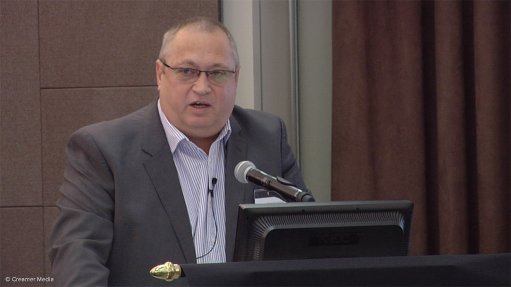
Neal Froneman
JOHANNESBURG (miningweekly.com) – The cumulative effect of several isolated operational incidents, coupled with a slow start-up of operations following the December holiday period, has narrowed Sibanye Gold’s production for the quarter ended March 31, by 5%, dragging gold output down from 332 400 oz in the first three months of the prior year to 315 300 oz in the period under review.
The dual-listed gold miner’s production was hampered by an underground fire at the Johannesburg-based Kloof mine’s 7 Shaft, the failure of a conveyor system at Kloof’s 8 Shaft, a production disruption resulting from inter-union conflict at the Beatrix mine, in the Free State, as well as a series of plant incidents that disrupted processing operations and resulted in above-desired stockpiles of reef at quarter-end.
Electricity load curtailment, as required by energy utility Eskom, also affected the processing of surface sources, the company said in an operating summary on Monday.
“The operational disruptions were primarily a factor in January and February, with the operational performance improving significantly during March. Opportunities to enhance productivity and recover gold production lost in the first two months of the year have been identified and implemented at all of the operations.
“As such, the yearly production forecast of between 1.61-million ounces and 1.67-million ounces remains unchanged,” Sibanye CEO Neal Froneman said.
As a result of the lower production during the quarter, group total cash costs for the quarter increased to $1 023/oz, while all-in costs for the period rose to $1 259/oz.
Combined gold production from the Beatrix mine, as well as the nearby Driefontein and Kloof operations, at 271 300 oz, was 18% lower than the first three months of the prior year, while the Cooke operation, in the Witwatersrand, was also affected by the slow start-up after the December break, but, at 44 000 oz, produced marginally more gold than in the same period last year.
Gold production from the surface operations was 40% higher year-on-year, at 40 500 oz, with the Cooke surface operations contributing 8 400 oz.
PROJECT PROGRESSION
Sibanye, meanwhile, continued the progression of its projects over the quarter, completing the prefeasibility studies (PFSs) for both the Kloof Shaft 4 and Driefontein Shaft 5 infrastructure projects.
Detailed feasibility studies for both projects remained on schedule for completion during the June quarter and, owing to the favourable forecast returns, initial preparatory project site preparation and development started at Kloof 4 Shaft in January, with the Driefontein 5 Shaft project preparation planned to begin in July.
A detailed feasibility study considering a phased development approach for the West Rand Tailing Retreatment project was also completed by the end of March and was currently undergoing an internal technical and financial review.
“This study has incorporated the use of available surface infrastructure to reduce upfront
capital and enhance value. The infrastructure used includes existing gold plants and elution capacity at Driefontein and Kloof, as well as uranium processing capacity at the Ezulwini metallurgical complex,” Froneman explained.
Metallurgical testwork undertaken during the study had further enabled refinements to the process design, resulting in reduced capital and operating costs. The outcome of the study would be released during the June quarter.
Capital expenditure of R286-million had, meanwhile, been approved in July last year for a 15-month construction programme to complete critical pumping infrastructure and realign the shaft steelwork at the Burnstone project.
The infrastructure project was on schedule for completion by the end of September, while the feasibility study and development of the life-of-mine plan was on schedule for completion in the June quarter.
“R150-million has been provisionally approved to begin mine development this year, with 2 000 m planned to be developed into the initial targeted mining areas by the end of
the year,” said the group.
Sibanye had also completed a PFS on the Beisa project, located in the Beatrix West Section, and was awaiting various regulatory approvals and permits before advancing this project.
WAGE TALKS
Adding on Monday that it would enter wage negotiations with organised labour in the June quarter, Sibanye noted that it, along with other miners represented by the Chamber of Mines, would approach the negotiations in a “balanced manner”, ensuring that any agreements remained in the interests of all stakeholders and did not compromise the long-term sustainability of the industry.
It added that, while the gold industry was cognisant of the social and economic issues affecting its employees and the communities close to its operations, many gold mines were marginal and inflated wage and benefits increases would significantly impact on the sustainability of the industry.
“While delivering short-term gains for employees and unions, [inflated wage hikes] will inevitably result in the loss of jobs and destroy value for all stakeholders in the longer term,” it cautioned.